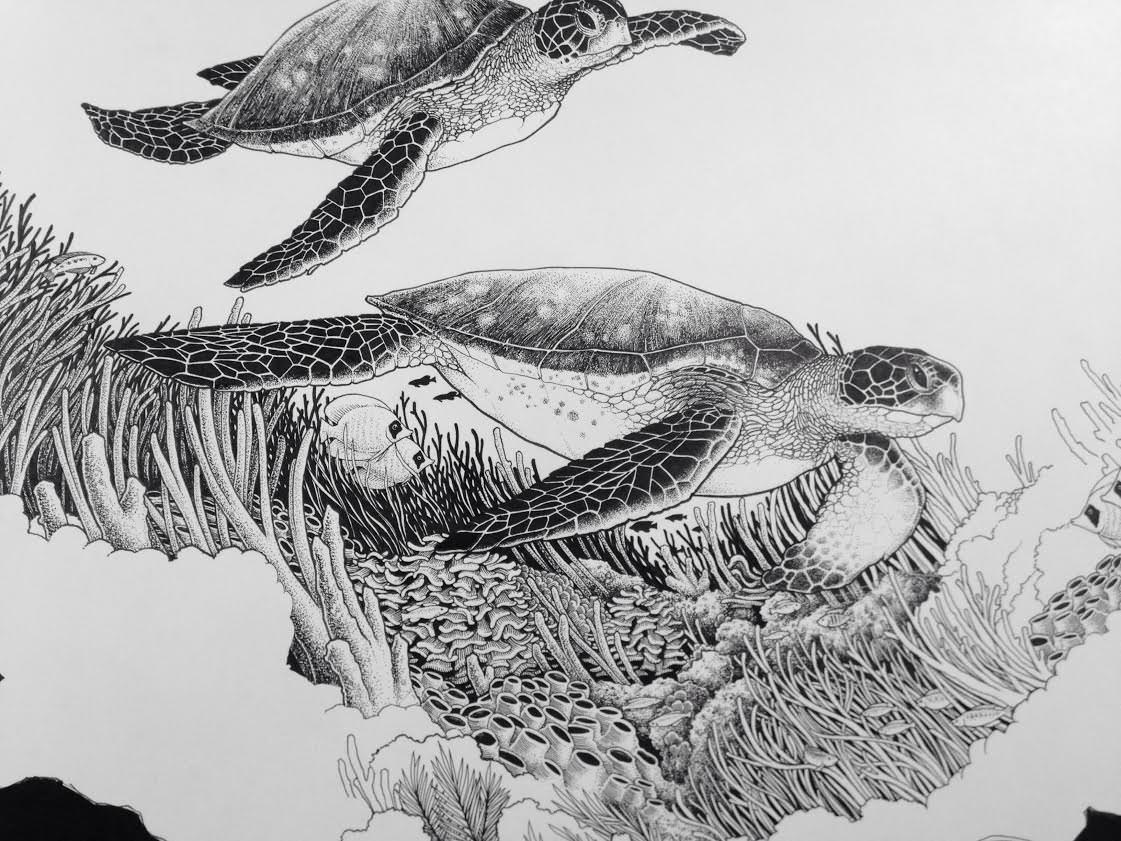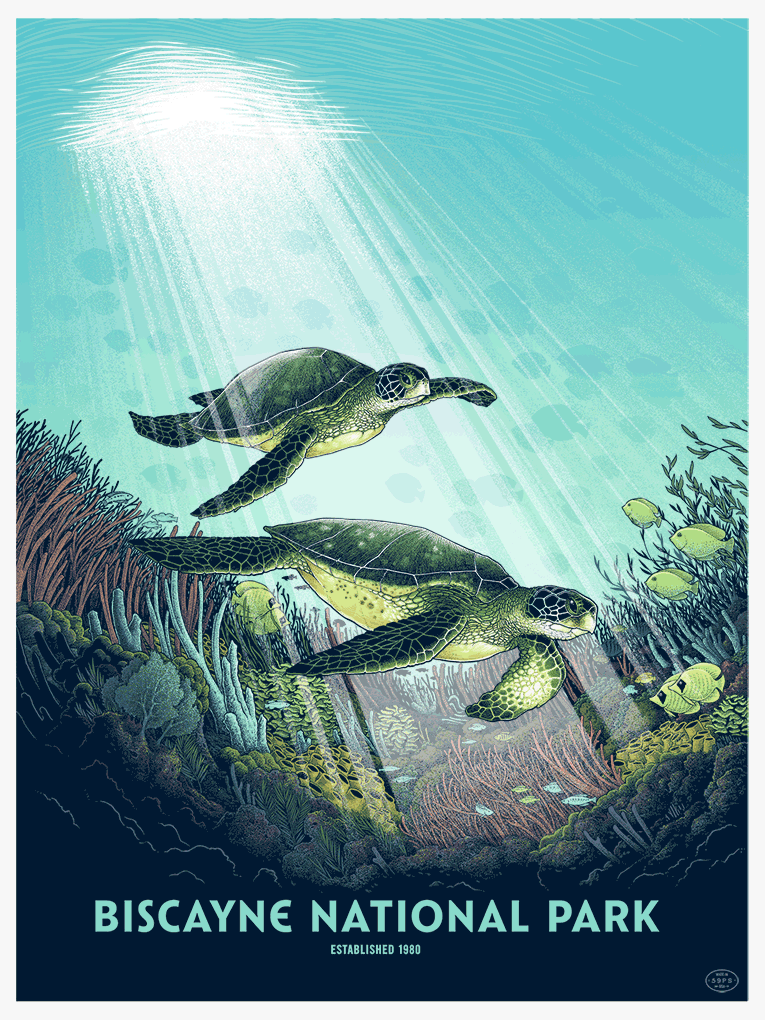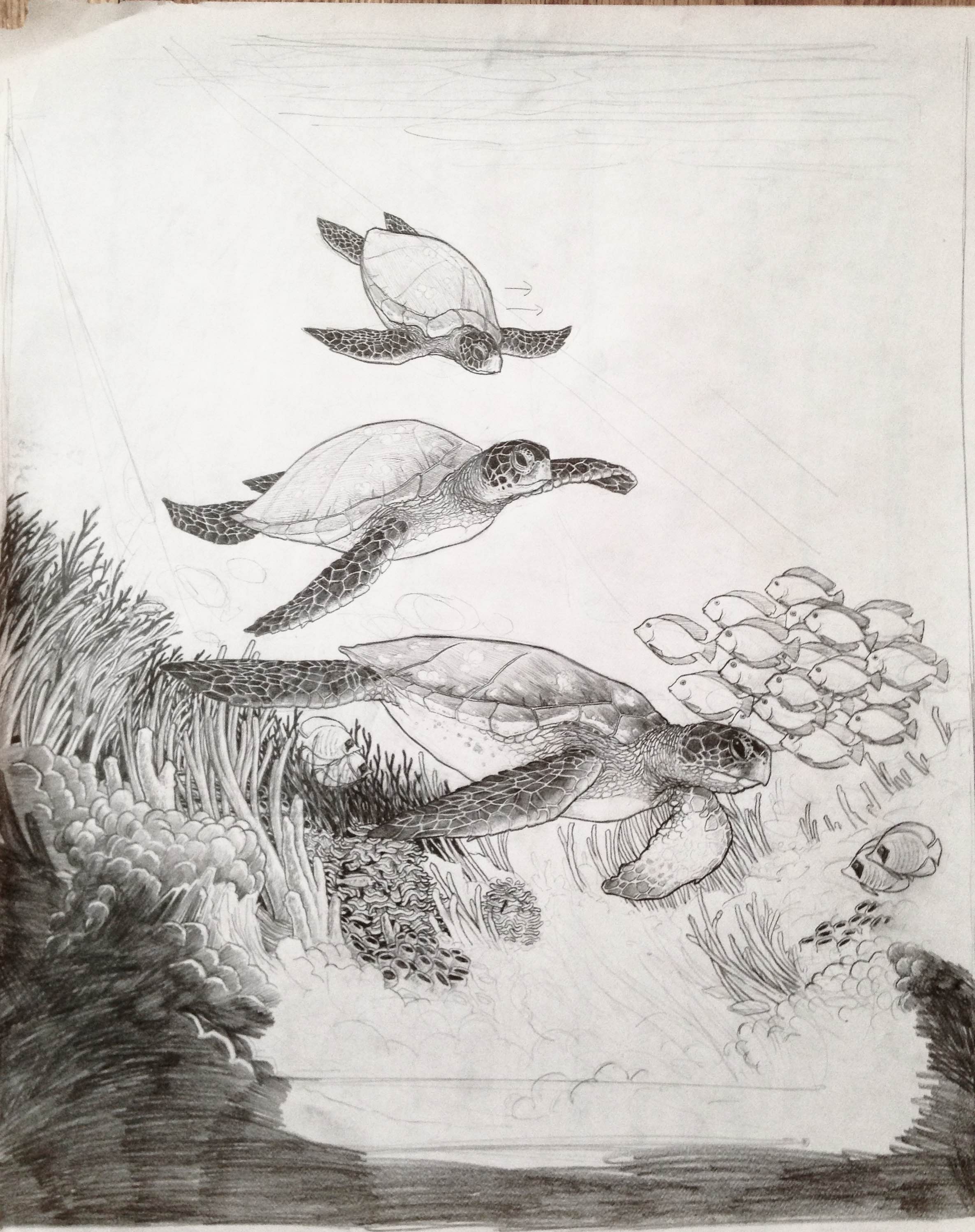It's unbelievable to see each artists defy expectations with the series so far. In this case, Justin Santora not only raised the bar for himself but for the entire project as well. We first talked to Justin about being a part of the project in early 2015. His enthusiasm was instantly apparent and totally appreciated. It shouldn't have come as a surprise but nearly a year later Justin's enthusiasm felt like it had grown exponentially. And it shows. Take one look at his poster for Biscayne and you'll see an artist who put every bit of themselves into this one. His admiration for wildlife is hard to deny and his attention to detail is second to none. This is an example of an artist confronting their own limitations and coming out even stronger on the other side. This week we had a chance to talk with Justin about coming up in the Chicago poster scene and the development of his craft. Enjoy!
Can you tell us a little about your origin story?
In the spring of 2008, I was completing a double major in studio art and secondary education. As I began student teaching, my interest in actually working in a high school began to wane quickly. I think this probably says more about me than it does about the profession. I just don't think I was at all suited for it.
I had a couple of chance meetings through the university I was attending that introduced me to the world of rock posters, specifically the work of Jay Ryan and Diana Sudyka. I admired how they each found ways to use their art and printing skills to essentially create careers for themselves. I held the path they chose up against the rigidity and predictability of student teaching, and suddenly all I wanted to do was draw and learn how to screen print. So I made a pact with myself that as soon as I finished school, I would start working whatever part time jobs I could and begin gathering screen printing materials so I could teach myself how to print.
Many of the artists and printers here in Chicago were precisely why I started making posters in the first place, and to so quickly be regarded as a peer by them was really special.
There were already enough people doing this professionally that it definitely seemed possible, but I wasn't entirely clear—nor was I all that concerned—about the specificity of how the whole thing might transpire. I suppose my plan was to get proficient enough at screen printing to start being hired to make rock posters and just see where that might lead.
I made my first rock poster in August of 2008, and I haven't looked back. The following January, an art print I made was featured on OMGPosters.com, and an interest in my work began to develop among some of the many poster collectors who pay pretty close attention to what people are making. By the spring of 2009, making screen printed art prints, posters, and doing miscellaneous illustration had become my full time job. The first couple of years were really about living as cheaply as I could in order to make the whole thing financially possible, but things grow over time and it gets a little easier every year.
This poster feels like a big leap forward in terms of your work. How does that feel? What do you think triggered such an inspired illustration?
The response this poster has gotten has been pretty awesome. I'm actually kind of relieved! I've heard a lot of incredibly nice things from close childhood friends to poster collectors to art directors to peers whose work I deeply respect.
I think the only way around this kind of illustration was straight through it. It's basically just that I wasn't going to draw a coral reef without doing my best to depict the labyrinthine quality they have. I just bit off a little more than I could chew and tried as hard as I could to rise to the occasion. I think that's how anybody progresses in anything, by jumping in and seeing if they can swim (pardon the pun).

Can you take us through each step of your process from sketch to completion?
I will always start out with a few really rough thumbnail sketches. These are no more than a few inches across and are just to get a feel for a very basic composition. Then I'll look at as many photos as I can to get ideas. This is followed by more sketches, likely a bit larger and more refined, but still very loose.
Once I've settled on a concept (or a few concepts), I will submit the roughs to the client. We'll decide on which direction to pursue, and I'll begin a full pencil drawing. These can be rough and look a bit scratchy or even get overworked in some areas, but the main purpose of these is to plan where everything will go and to serve as a guide for the final ink drawing.
Inking is done by taping a clean sheet of paper on top of the pencil drawing and turning my light table on. I use various technical pens, brush pens, and sometimes brushes to ink the drawing. I'll also use opaque white ink or paint for small corrections and occasionally for a bit of reductive drawing.
Once the ink is finished, I will scan it and bring it into Photoshop and begin planning the colors. Some of the color separations involved more drawing, which I almost always do directly on the screen of my tablet monitor. Color on this print took a bit longer than I thought, as I wanted to make sure the reef was colorful enough and that the color choices were maximized and used to create as much depth as possible. I had a lot of feedback from some artist friends who really helped me achieve this as closely as I could. That's actually not something I normally do, but I should totally start to make a habit of bouncing ideas off other minds and fresh sets of eyes. I learned a ton just by showing this thing to a few very smart friends.

With over 100 species of fish, 200 species of birds and 25 mammal species, what was so compelling about the beautiful sea turtles you put on center stage?
Sea turtles have been one of my favorite animals since I was a kid. For as powerful and elegant as they look in the water, they seem so delicate. Maybe it's the fact that they're a threatened species, which has always really bothered me. I'm really touched when I see some of the measures humans will go to just to ensure they can use beaches to lay eggs safely.
When I began doing some research about Biscayne Bay, images of sea turtles popped up pretty quickly. I don't think there was a whole lot of thought about whether or not I would draw sea turtles for this poster. It was decided before I even picked up a pencil. They're too cool not to draw.
I had a concept in the works which simultaneously depicted the surface of the water from above as well as below. There was going to be a few brown pelicans diving for fish at the top, while the coral reef, fish, and turtles lurked down near the bottom. As much as I would have loved to do this, I think it would have taken a whole extra week to complete, and I feared I would have had to sacrifice a bit too much detail in pursuit of a proper balance between the underwater and above-water sections of the composition. Damn, I'm still really wondering if I could have pulled that off, though.
This poster doesn't feel like a total departure from the work we're used to seeing but it still feels different enough. Was that challenging for you or did you feel right at home illustrating a scene from nature?I was out of my comfort zone at times while drawing this, but at other times I was on really familiar ground. A big part of illustration, I think, is constantly figuring out how to render different objects. Some of this stuff, I'd drawn before. Other parts of it, I hadn't. I have a lot of trouble with rocks and rock formations, so I knew that was going to be a hurdle. I'd done some sea turtle and coral studies in my sketchbook, so I was kind of prepared for that. I tend to a put a lot of pressure on myself when it comes to working in ink; I want every pen stroke to count. So I really like to have a plan for how I'll ink each part of a drawing. I'm also acutely aware of areas where I feel I need to improve, so the longer I think about a drawing, the less likely it is that I'll ever just jump straight into the inking process. The whole ordeal of planning, experimenting, and finally putting ink down on a final drawing--especially when drawing outside of one's comfort zone—is rife with opportunities to learn and hone your craft.
What's your favorite thing about The National Parks?
I think the single most important thing about national parks is the element of preservation. Since the Industrial Revolution, humans have been wrecking the planet at an absolutely devastating pace. I think the fact that we can use government to draw some kind of line and ensure that a portion of the planet's natural beauty be preserved and protected is by itself a monumental achievement. Now, it shouldn't have to be regarded as an achievement, but given the monolithic force of modern industry, I think there's something to be said for anything mitigates such a selfish and shortsighted trajectory and considers the needs of other species. The planet belongs to more than just humans, and while The National Parks do seek to give us humans access to the splendor of natural world, they also allow portions of the earth to remain safe from development so that other creatures and ecosystems can continue to thrive. I mean, these places are already developed. They just developed differently and independently of capitalism. It's only human arrogance that determines a hotel is "better" than a marsh.

Just looking at some of your work (and this poster as well) there's a certain appreciation and admiration for animals that comes across in your work. Can you talk about your passion for animal rights?
For some reason I'm always surprised when people take notice of how I depict animals, but they're regularly on my mind and have always been something I'm drawn to. I guess I forget how often they pop up in my illustrations. I've loved animals for as long as I can remember, but it wasn't until 2004-2005 that I began really learning about how animals are treated in factory farms and how I could limit my contribution to unnecessary animal suffering by making different diet and lifestyle choices. I've been vegan since late 2005, and it's by far one of the best decisions I've ever made.
While I would enthusiastically recommend it to anybody, going vegan was a personal choice and I in no way judge others' decisions or say they "aren't doing enough" or anything like that. I think the majority of people are uncomfortable with animal cruelty, but the intrinsic barbarism of the meat and dairy industries is very deliberately kept from the consumer. I will sometimes look at my beloved cat and wish that all animals could live the life of comfort and safety that he gets to live, and it really hurts to know that animals who are just as capable as him of feeling pain, fear, affection, and emotion will be treated as unfeeling machines for profit.
There's only so much one person can do, and if I think about it enough, I pretty quickly realize I could be doing a lot more to help animals as well as further mitigate my ecological impact. I just try to do my best, and for me that means doing everything I can as a consumer within the current framework to not support industries that capitalize on animal suffering. That's what makes sense to me.
What's it like being a part of the prolific poster community in Chicago?
Many of the artists and printers here in Chicago were precisely why I started making posters in the first place, and to so quickly be regarded as a peer by them was really special. I suppose if there wasn't such a globally connected poster scene like there is now with the internet, social media, and various Flatstocks and other trade show events, I might have just assumed every city is this inclusive and welcoming. I know amazing people from all over the world who make posters, but I regularly hear people from other cities remark about how connected and friendly our community is here. I try not to take it for granted because I know I'm really lucky to be making posters in Chicago.

You're one of a handful of artists who opted to print the first run of posters yourself. What is it about printing that gets you the most stoked?
I've always printed my own posters, so it's still pretty entrenched in my business model. When I started out about eight years ago, I think it was more common for poster artists to handle production. It almost seems like the opposite is true now, which is totally fine, of course. I see pros and cons with both models, and I think each artist just has to do what is right for him or her. Printing my own stuff is what initially made it possible to make this into a viable living for me, and I still enjoy doing it. Printing can be stressful, too, but so can a lot of things.
There's something pretty awesome about just settling into place behind the press with headphones on, a stack of a paper and bucket of ink next to you, and a couple of drying racks to fill up.
What's next for you? Are there any upcoming projects that you're stoked on?
Yes! I currently have a full schedule that I'm really excited about. I'll be in Austin this week for Flatstock 53 and "House Party," a big group exhibition at the Mondo Gallery. I'm working on my first movie poster right now, I have a few art prints planned, some album art, some gig posters, and bit more illustration/poster work for internet cat sensation Lil Bub. And a few surprises, for sure.
More than anything, I'm stoked to keep having opportunities to do work for so many cool people who are doing rad things. I'm just pumped to keep moving forward and doing the best I possibly can!





